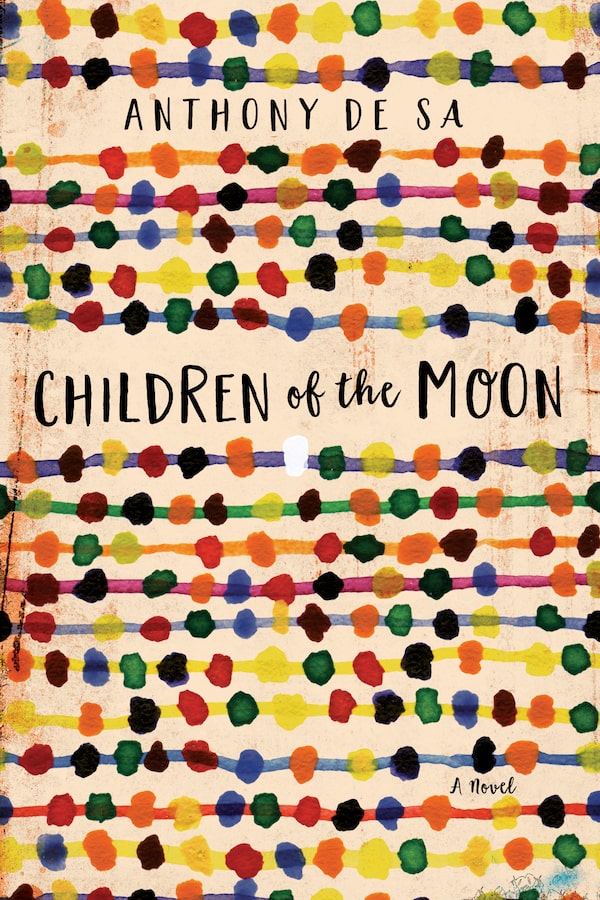
Children of the Moon by Anthony De Sa.
- Children of the Moon
- Author: Anthony De Sa
- Genre: Fiction
- Publisher: Doubleday Canada
- Pages: 256
When Antonio, the young narrator of Anthony De Sa’s first novel, Kicking the Sky, visits the courthouse at Toronto’s Old City Hall, he says, “The janitors were all Portuguese, I could tell. … Their hands bore the five-dot tattoo. Those who served in the army in Africa, in Angola or Mozambique – the blood bath, my uncle Clemente called it – all sported the five blue dots tattooed on their hands, near the webbing between their thumbs and pointer fingers. Five dots for the five wounds inflicted upon Jesus during the crucifixion.”

Anthony De Sa.Supplied
The five wounds of Christ, also depicted on the shield of the Portuguese flag, make another tattooed appearance in De Sa’s latest novel. Set in part during the 1964–74 Mozambican War of Independence from Portugal, Children of the Moon represents a departure for De Sa. His previous books, the linked short-story collection Barnacle Love and Kicking the Sky, both followed Antonio Rebelo, his family living at 55 Palmerston Ave., and the Lusophone community of Toronto’s Little Portugal, composed of Portuguese and Azoreans (such as the Rebelos) as well as people from former Portuguese colonies.
Children of the Moon makes a partial break from this setting, with a whole new cast of characters. Opening with Pó telling the story of her birth in Tanzania in 1956, the narrative then switches to Serafim, a Brazilian journalist visiting Beira, Mozambique, to write an article on the persecution of people with albinism in Africa, such as Pó. His article will feature the community Pó has formed there in a dilapidated former hotel, as well as Pó herself, but Serafim’s line of questioning causes some tension between the two. “I am telling you my story as stories should be told,” she says.
The novel’s third narrator is Ezequiel, a man living in Toronto who two years prior was diagnosed with Lewy body dementia, a degenerative disease. Pó and Ezequiel share a connection from the Mozambican War, although what it is and the circumstances of their separation are not clear until novel’s end. Only with Ezequiel’s story does De Sa return somewhat to his previous books’ stomping grounds.
The history of nearby St. Mary’s Church on Bathurst Street tells of the waves of immigration that shaped this neighbourhood. Established by Irish immigrants in 1852, the church then saw an increase in Ukrainian and Polish parishioners, followed by an influx of Portuguese and Azoreans in the 1960s. The church, featured in both Barnacle Love and Kicking the Sky, today still delivers mass in Portuguese as well as English. The cross-street that runs along its north side was renamed Portugal Square.
These signs of the Portuguese community’s dominance belie the intense gentrification of Queen Street West, including Little Portugal, in the past 15 years. For anyone familiar with these streets, De Sa’s earlier books – set largely in the late 1970s to early 80s – offer either a trip down memory lane (the author grew up here, the son of immigrants, during the same years as his character Antonio) or a window into when this was truly an ethnic enclave. Many of the Portuguese bakeries and some backyard vegetable patches remain, as do the churches and maze of laneways, but when was the last time someone on Palmerston used their garage for butchering a pig? Today’s garages are more likely to be converted into home offices or laneway housing.
It is in this contemporary Toronto that Ezequiel’s sections of Children of the Moon take place, although Ezequiel’s creeping dementia blurs past and present, Mozambique and Toronto. The contrast between this present version of Little Portugal and the one De Sa represented in his earlier works is notable. Ezequiel is 64, but his world is narrowly circumscribed to what one would imagine of a significantly older man: He keeps to his basement, while renting the rest of his house to a family barely present in the novel. Dementia isolates a person, but so does the loss of community: Gone in this novel is the gossip at the corner store, the extensive network of cousins and the unifying ritual of wine-making. The corner store is itself no more, as Ezequiel learns when he goes to buy milk: “Senhor Leonildo’s convenience store on the corner opens early, but when I tug at the door it is locked. Peering inside, I don’t recognize anything. I see half a dozen large chairs with foot sinks. The sign reads NAIL SPA. I don’t know where Senhor Leonildo’s store has gone. I’m certain it was here yesterday.”
In the absence of a community to look after him, an army of home-care nurses visit Ezequiel. It is not the same.
It might seem strange that a review of a novel set during the Portuguese Colonial War (of which the Mozambican war was a part), would make so much of gentrification in Toronto. The war, and the racism inherent to the colonial project that produced that war, is more than backdrop in Children of the Moon. Ezequiel receives the five-dot tattoo from a particularly sadistic Portuguese commander, who calls Ezequiel “half-blood” as he pricks his skin. Ezequiel didn’t ask that the Shield of Portugal be cut into his hand.
Yet the war is the circumstance of the novel, not its subject. Community and isolation, the significance of memory and story: these are its themes, applicable in Beira or Toronto. Children of the Moon’s climax is strangely flat, given the narrative is built for saudade, or nostalgia for the missing. De Sa achieved greater poignancy in his first two books, particularly in representing his characters’ disappointments, but fans of his previous work will likely find something here in his oeuvre’s expanding view of Lusophone Toronto.
Expand your mind and build your reading list with the Books newsletter. Sign up today.